Message from the Executive Committee
After collating data and crunching numbers from last season’s crop production research, its time again for land preparation, seed weighing, and a myriad of activities related to planting as we enter the second quarter of year 3. Some of our northern sites already have site relevant studies in the ground. Among several focus areas in this growing season, one particular area is to tailor best management practices to different locations within the SE, especially with respect to optimum planting dates. Our modelers and on-the-ground data gatherers continue to brainstorm most relevant scenarios to model from the perspective of applicability for multiple SPARC stakeholders. The Freight and Transportation Optimization Tool (FTOT) originally developed by US DOTs Volpe is now being optimized for carinata production and logistics. The tool helps identify, optimum routes depending on existing infrastructure and subsequently, sites for future infrastructure development depending on production hubs and end user destinations. All these capabilities within SPARC allows us to furnish relevant information to decision makers as we move along on our mission to commercialize carinata. During this process, the importance of data users (modelers) fully understanding the method of data gathering cannot be overemphasized. So let’s keep at it and produce outstanding science to elevate (our knowledge), extend, and educate.
SPARC Stories
Testing Advanced Carinata Varieties Across the Southeast
This summer, I took part in an 8-week internship with the ARA fuels team in conjunction with the SPARC project. I performed various tasks, both directly, and indirectly, advancing the progress of the SPARC project. This work included operation of the Hydrothermal Cleanup (HCU) and Catalytic Hydrothermolysis (CH) units, continued exploration and integration of SPARC coproducts, development of process flow diagrams, and research into brown grease suppliers.
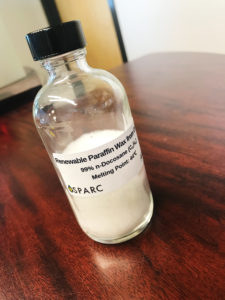
Renewable wax sample from Carinata
A direct contribution made to the SPARC project was research into viable coproducts. Last summer, I was assigned the task of identifying the most viable coproducts by analyzing many different factors such as market demand, price, and profitability. The coproducts found to be most profitable were Erucic acid (a 22-carbon unsaturated fatty acid) and its derivatives.
Continuing this research, my work on coproduct development this summer was focused on actual production of C22 coproducts using ARA’s processes. A valuable erucic acid derivative is behenyl alcohol (a saturated 22-carbon alcohol), and we predict the most efficient way to produce it is from fatty acid methyl esters. I was tasked with identifying the most favorable conditions and catalyst for producing fatty alcohols from FAME. This research is related to the goal of producing FAME from carinata, then distilling the product to obtain the 22-carbon FAME, which is the precursor for behenyl alcohol. I also prepared samples of n-Docosane (C22 renewable paraffin wax) which was produced from carinata oil.
Another of my responsibilities during this internship was to identify where most brown grease is being collected and treated, then to contact these facilities to inquire about obtaining samples or consistent supply. I found that most wastewater treatments no longer accept brown grease. Instead, most brown grease is collected and processed by independent environmental companies. Once these companies were identified, I began conversations about their potential of becoming brown grease suppliers for ARA’s renewable fuels.
Development of weed control tools for Brassica carinata
Weeds are the main cause of yield loss only second to drought worldwide, so they represent one of the most critical challenges for developing a new crop. It is for this reason that the efforts of the Southeast Partnership for Advanced Renewables from Carinata (SPARC) to make Brassica carinata a sustainable feedstock include identifying existing and developing new weed control tools.
Most weed control tools, especially herbicides, are developed for crops with large acreage such as corn, soybean, and cotton. Therefore, specialty and new crops depend on the existing control options that have been commercialized for conventional crops. During the last three years, SPARC has been screening the safety of multiple herbicides used in major conventional crops and some vegetable crops on B. carinata to identify those that can provide acceptable weed control without reducing yield due to herbicide injury. This has proven challenging because, as other crops from the Brassicaceae family, B. carinata is very sensitive to many herbicides. Thus, most herbicides that at the label rate provide acceptable weed control, also could cause yield reductions or even plant mortality in B. carinata. It is important to highlight that this situation is a similar to other crops such as canola/oilseed rape, radish, broccoli, cabbage, etc. The good news is that SPARC has identified several herbicides that are commercially available that can be used to provide effective weed control of many winter weeds without negatively affecting B. carinata growth and production. Those herbicides include pendimethalin and S-metolachlor for preemergence weed control and clopyralid and fluazifop-P-butyl for postemergence control of broadleaved and grass weeds, respectively. Although this is a small number of herbicides, they are a basic set of tools that when complemented with adequate cultural practices (planting and fertilization strategies) allow the implementation of effective integrated management strategies.
Research is currently underway to identify other herbicides that can be safely used in B. carinata. Promising preliminary results suggest that there are potential herbicides with other mechanisms of action that could be used to increase the spectrum of weed control in this crop (Fig. 1).
Fig. 1. Herbicide tolerance experiments in Salisbury, NC. The yellow frame indicates areas treated with herbicides that were lethal to Brassica carinata. Plants outside the yellow frame were tolerant to different herbicides.
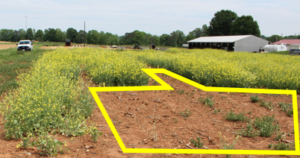
Wild radish is perhaps the most challenging weed to control in B. carinata fields. Because this weed is closely related to B. carinata, it exhibits similar levels of tolerance to those herbicides that are safe for this crop. This means that although we can control many other weed species with the aforementioned herbicides, wild radish control is limited. In order to overcome this problem, SPARC researchers, mainly through Agrisoma breeding program, have been developing B. carinata germplasm with increased herbicide tolerance, which will allow using rates that are lethal to wild radish and safe to this crop (Fig. 2). An advantage of this approach is that the gain in herbicide tolerance also reduces the risk of injury due to carry-over of herbicides applied in previous crops. In this way, growers will have more flexibility for include B. carinata in diverse crop rotations.
Fig. 2. Identification of Brassica carinata genotypes with increased herbicide tolerance. Plants within the red frame were able to tolerate herbicides better than the ones outside the frame.
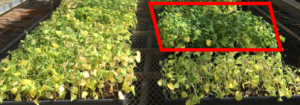 As part of the process of immersing agriculture in the digital era, SPARC is also generating tools to help B. carinata growers to automate decision-making based on weather networks and weed growth requirements. For example, a model was developed for wild radish, which allows using georeferenced data from the National Oceanic and Atmospheric Agency (NOAA) or local automated weather stations to predict the timing of wild radish emergence and when it reaches different growth stages. In this way, growers will know when to conduct activities such as crop planting, herbicide applications, and cultivation to maximize wild radish control. Similar predictive models are being developed for other winter weeds that can interfere with B. carinata growth.
As part of the process of immersing agriculture in the digital era, SPARC is also generating tools to help B. carinata growers to automate decision-making based on weather networks and weed growth requirements. For example, a model was developed for wild radish, which allows using georeferenced data from the National Oceanic and Atmospheric Agency (NOAA) or local automated weather stations to predict the timing of wild radish emergence and when it reaches different growth stages. In this way, growers will know when to conduct activities such as crop planting, herbicide applications, and cultivation to maximize wild radish control. Similar predictive models are being developed for other winter weeds that can interfere with B. carinata growth.
Days after soil preparation
Growing-Degree Days with Daylength Restriction
Days after soil preparation
Growing-Degree Days with Daylength Restriction
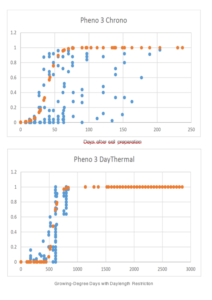 Fig. 3. Predictive model for wild radish flowering time probability (orange dots). Wild radish exhibits large variability in flowering time (upper panel; blue dots indicate real observations), but using a thermal-time model with daylength restrictions allowed to explain most of the flowering time of this weed (lower panel).
Fig. 3. Predictive model for wild radish flowering time probability (orange dots). Wild radish exhibits large variability in flowering time (upper panel; blue dots indicate real observations), but using a thermal-time model with daylength restrictions allowed to explain most of the flowering time of this weed (lower panel).
Ensuring that B. carinata production will fit within existing crop rotations without affecting production and ecological process is very important. Therefore, we are studying whether the population dynamics of winter and summer annual weeds systems are affected by introducing B. carinata as a new component of the crop rotation. The premise is that a new crop should either have a null or positive, but definitively not a negative impact effect on the productivity and management of the existing crops. After completing a full cycle of rotation, the results suggest that B. carinata is not only compatible with existing summer crops in the Southeastern region, but could help reduce the populations of several weed species, although more research is needed to confirm these preliminary findings.
SPARC has implemented a unique and diverse strategy to develop options that will help B. carinata growers manage weeds in a cost-effective and integrated fashion. Furthermore, this strategy will progressively generate more control tools ensuring growers have the necessary flexibility to implement a weed management in accordance with their needs and preferences.
SPARC Member Spotlight
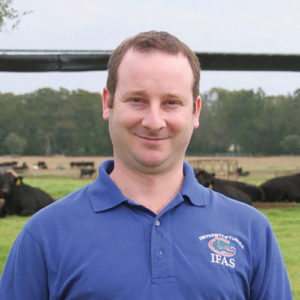
Dr. Nicolas DiLorenzo, a native of La Plata, Argentina grew up in a family with deep roots in agriculture. His passion for agriculture, and beef production in particular, is partially due to the fact the he grew up working on the family owned 3700-acre ranch in the heart of the beef production province of Buenos Aires, Argentina. Nicolas first came to the U.S. in 2000, when he participated in an internship program through the University of Minnesota. As a result of that, Nicolas lived and worked on a farm in Northwest Iowa where he helped with the daily chores of a family-owned operation specialized in row crops, farrow to finish swine production and beef cattle backgrounding. After 18 months in the U.S. he returned to Argentina to complete his degree in agricultural engineering at the Universidad Nacional de La Plata. In September of 2002, Nicolas returned to the U.S. to pursue graduate studies at the University of Minnesota, where he obtained his master’s degree in 2004 and his PhD in 2008, both in Animal Science with emphasis in beef nutrition. From July of 2008 to July of 2010 Nicolas worked as a postdoctoral research associate at Texas Tech University in Lubbock, TX, conducting and coordinating research trials in the area of feedlot nutrition and management. In August of 2010 he joined the University of Florida as an Assistant Professor in Animal Sciences at the North Florida Research and Education Center in Marianna, and was promoted to Associate Professor in 2016. His primary research and extension interests are in the area of beef cattle nutrition, with the objective of improving the efficiency of use of forages and byproducts, minimizing the environmental impact of livestock production. His research and extension programs focus on ruminal metabolism and fermentation, emissions of greenhouse gases, and nutrient use efficiency in livestock systems.
Nicolas brings his strong background and experience in animal nutrition to SPARC. As lead of the meal efficiency team of SPARC, Nicolas not only designs studies related to beef nutrition but also coordinates other team members working on various aspects of carinata meal, be it in different animal systems or coproduct development from meal. Nicolas is very enterprising in nature and is always on the lookout for unique collaborations, especially between academia and industry, and enhancing the overall project.
Nicolas, his wife Liza, their 8-year-old daughter Luciana, and their dog Tana, enjoy traveling, outdoor activities, and fishing whenever possible. Nicolas’ hobbies include playing soccer, grilling, reading, and fishing. Nicolas is still trying to adapt his fishing skills, patiently developed in the freshwater lakes of the Midwestern U.S., to the more challenging fishing environments (both saltwater and freshwater) of Florida. Luckily for Nicolas, there are plenty of experienced fishermen in Florida always willing to offer a good fishing tip.
SPARC Student Spotlight
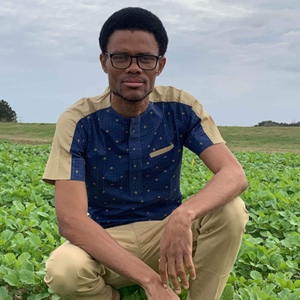
Joseph Iboyi-University of Florida (Mulvaney)
Joseph Iboyi is a SPARC graduate student in agronomy at the University of Florida’s West Florida Research and Education Center under the supervision of Dr. Mike Mulvaney. Joseph’s research focus is on integrating carinata into existing cropping systems in the SE US with a focus on best management practices and nutrient use efficiency. Prior to coming to the University of Florida, Joseph completed his master’s degree in agronomy and plant breeding at the University of Ibadan in Nigeria, and a bachelor’s degree in crop science at the University of Benin, in Benin, Nigeria. As a graduate research intern at Ibadan he acquired a diverse skill set ranging from molecular biology techniques to using UAVs for phenotyping cassava genotypes, to phenotypic and genotypic analysis. He has tremendous teaching experience through his role as a graduate student trainer on the use of molecular markers for crop improvement, and tutoring several graduate students in experimental methods in plant breeding and advanced genetics. As an agricultural technical advisor he is experienced in stakeholder engagement as he facilitated monthly technology review meetings with stakeholders at the agriculture ministry and agricultural institutions at Ebonoyi State, facilitated training programs and workshops for farmers and other entrepreneurs, developed strategies for improving organizational skills to provide enhanced services to local farmers etc. He also led meetings of the Young Farmer’s club at local schools in Abakaliki and Izzi regions of Ebonoyi State. In his research career so far, Joseph has gained diverse experience working with a wide variety of commodities such as row crops, horticultural crops, roots and tubers, cash crops such as oil palm, cocoa, rubber, cashew, coffee, tea, and livestock.
Joseph is extremely industrious and not in favor of taking any short cuts when it comes to realizing his research objectives. He is totally immersed in his research and claims that his extracurricular activities are usually related to research as well. However, whenever time permits he loves to watch documentaries, and travel.

Karyn Moses
Karyn Moses is a doctoral student at the University of Florida’s Agricultural & Biological Engineering department under the supervision of Dr. Zhaohui Tong. She has six years of education in the fields of chemical engineering, chemical processes, chemical reactions/kinetics, and environmental engineering as well as three years of training in the fields of agricultural and biological engineering, polymer chemistry, and packaging design for food and food products. Karyn received a Bachelor of Science degree in chemical engineering with a concentration in environmental engineering at Tuskegee University. She also received a Master of Science degree in chemical engineering with high honors, which increased her admiration for the field of engineering and its practices.
With an overarching focus on making impactful strides toward achieving food security, Karyn’s doctoral work is in the area of developing bio-based food packaging materials with food spoilage detection function, and application of algorithmic approaches such as machine learning to transfer food quality information to the customers through this smart packaging film. Karyn pursues a similar line of research on carinata derived coproducts as a SPARC student.
With knowledge of several multi-disciplinary professional engineering concepts, principles, practices, techniques, materials, and equipment, Karyn is well-positioned to excel in entrepreneurship, leadership and innovation as she collaborates with peers and others in the field.
In addition to her UF research and education, Karyn has played an important role as a mentor during her career so far. Holding a TAT (Temporary Authority to Teach) for the state of practice, she taught 9th grade physical science at Northshore Charter School in Louisiana. During her tenure, she worked with high-school students teaching principles of physics and chemistry in both classroom and laboratory settings. She also was a teaching assistant/co-professor at the Sante-Fe Community College in San-Antonio, Texas. She enhanced the laboratory skills of students, developed, evaluated, and delivered solutions/lessons derived by experimentation and laboratory operations.
Although Karyn has a strong passion for her academic career, she continues to enjoy her participation in community service projects for youth and the underprivileged, reading, traveling, spending time with her family, and building her network of success.
Member Spotlight
SPARC Events & Activities
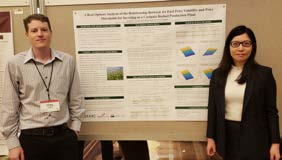
Andrea Zhao and Greg Colson presented joint research with Berna Karali and George Philippidis in the Agribusiness Economics and Management section at the 2019 annual meetings of the Agricultural and Applied Economics Association. Held in Atlanta, GA, the meetings attract over 1,400 professionals and graduate students from academic, government, and industry backgrounds with interests related to agriculture, energy, and natural resource economics.
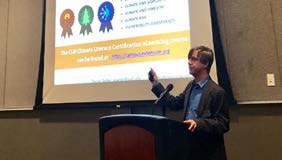
Dan Geller attended the 2019 National Association County Agricultural Agents (NACAA) Annual Meeting and Professional Improvement Conference on September 9th in Fort Wayne, Indiana. Dan presented on carinata and SPARC to 78 extension agents from around the county during the “Climate Change Super Session”.
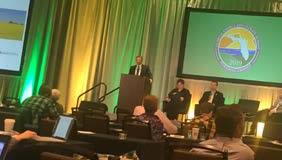
Drs. George Philippidis and Dan Geller attended the Florida Energy & Climate Summit at Tampa, FL on October 1-3, 2019. SPARC and carinata was featured in Dr.Philippidis’ presentation on the ongoing renewable energy R&D at the University of South FL
Upcoming Events:
January 28, 2020: 2-4pm ET: All-team meeting featuring Freight Transportation and Optimization Tool (FTOT) optimization for carinata by SPARC supply chain team members Seckin Ozkul and Rob Hooker.
The all-team meetings will take place quarterly and feature a topic of interest relevant to the SPARC mission, followed by a panel discussion. These meetings will also provide an opportunity for the executive committee and all the teams to share updates.
February 26-28, 2020: 7th Carinata Biomaterials Summit & 3rd SPARC Annual Meeting at University of South Florida, Patel College of Sustainability, Tampa, FL



















